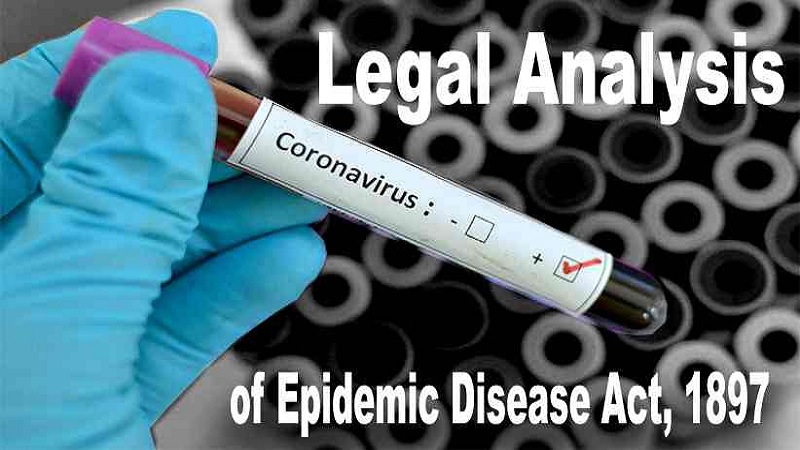 Image Courtesy: lawstreet.co
Image Courtesy: lawstreet.co
On April 22 came the ordinance from the President of India, approved by the Cabinet, amending the Epidemic Diseases Act, the colonial era law which has been invoked due to the outbreak of COVID19 epidemic. While containing the disease and treating is and should be the primary focus of the government, these are not the only issues that have besieged India since the lockdown.
Issues like dissemination of fake news, attempts to disturb communal harmony, promoting enmity between religions, blatant misinformation pose formidable challenges in the fight against COVID19. Yet, the government has selectively chosen to address one issue, that of violent attacks against on-duty health care workers. There is no denying that health care workers are on the frontline and the most important functionaries during this health crisis and protecting them should be the top priority of the government.
The central government, has, however, gone a tad bit further in doing that by amending the Epidemic Diseases Act via the ordinance route and introducing long prison sentences and hefty fines as punishments for attacks on health care workers.
Section 2B has been inserted which says that, “No person shall indulge in any act of violence against a healthcare service personnel or cause any damage or loss to any property during an epidemic.”
In section 1A the terms “acts of violence” and “healthcare service personnel” have been defined. While the term “healthcare service personnel” has been defined to include not just primary health care workers such as doctors, nurses and paramedics, but also workers at community level like ASHA workers who are also contributing considerably, and any other person so empowered by the government.
The terms “acts of violence” includes not just causing hurt, but also includes acts of harassment and causing hindrance as well as damage to their property.
These definitions have clearly drawn influence from real incidents that have taken place in various parts of the country where health care workers have been attacked with stones, ambulance drivers have been injured, doctors who come to containment zones to test people for the disease have been chased away. The magnitude of the problem cannot be denied, yet the weightage given to these offences are incongruent with existing criminal laws in the country.
There are two ways of looking at the way the offences have been dealt with. One can say that the hefty fine and the long term of imprisonment can prove to be a serious deterrent to future offenders and the other view point is that it can become a tool of harassment at the hands of law enforcement agencies. Naturally, all acts of violence against health care workers will now be classified under this new ordinance, making it easier for the police to book offenders and take urgent cognizance of such incidents. The same thing happened when lockdown was initiated and government order directed that violators of lockdown be booked under section 188 of the Indian penal Code which has a minor punishment of 1 month of imprisonment and Rs. 1,000 in fine. The police started booking hundreds of people under this section. Albeit, the scope for misuse here is much more since the crime need not be defined very clearly under section 188.
There is also no denying that there is some scope for misuse under the offences defined in the ordinance as well; since a mere act of causing hindrance to a health care worker can also be deemed to be an act of violence, for which the punishment is minimum 3 months and maximum 5 years and fine of at least Rs. 50,000 which may extend up to 2 lakhs.
Additionally, if found guilty by the court, the convict will have to separately pay compensation to the complainant.
In absence of the ordinance, a person committing such an offence of causing “hurt” would be booked under section 323 of the Indian Penal Code – Punishment for voluntarily causing hurt
—Whoever, except in the case provided for by section 334, voluntarily causes hurt, shall be punished with imprisonment of either description for a term which may extend to one year, or with fine which may extend to one thousand rupees, or with both.
It is only causing grievous hurt that invites a much harsher punishment even in the IPC. Grievous hurt is defined in IPC to include heinous acts like emasculation, privation of sight, hearing, limbs, disfigurement of face and such other. The punishment for grievous hurt is up to 7 years and fine, which is to be decided as per discretion of the court. On the other hand, punishment for grievous hurt under the ordinance is up to 7 years and the fine ranges from 1 lakh to 5 lakhs, plus compensation as mentioned before.
Clearly, the ordinance has made a less grave offence into a grave offence by according more punishment to just causing hurt. Also, causing hurt is a bailable and non-cognizable offence under the IPC, while it has been made non-bailable and cognizable under the new ordinance, which specifically aims to protect health care workers during this epidemic.
This ordinance may have come as a relief to doctors, nurses and other health care workers who are on the frontline, risking their lives, but it surely is not in tandem with the existing criminal laws in India. Whether the escalation of these offences prove to be deterrent, is something only time can tell.
Related: